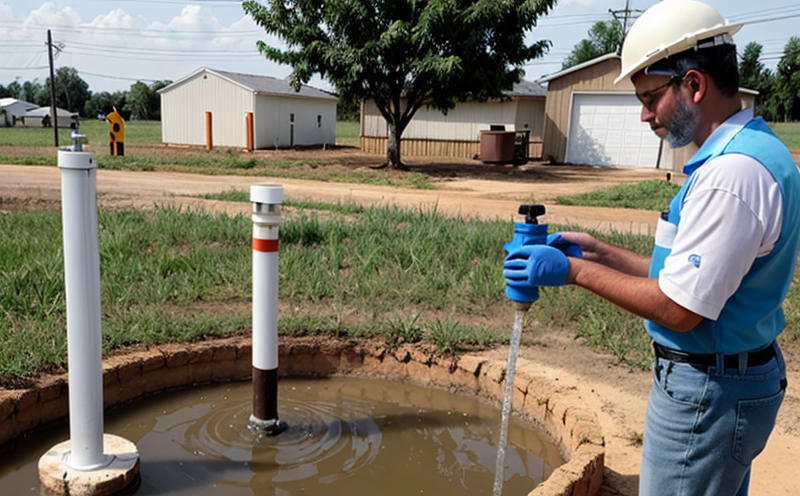ISO 13164-4 Tritium Activity Testing
The ISO 13164 series of standards provides a comprehensive framework for measuring tritium in water and wastewater, with ISO 13164-4 specifically addressing the determination of tritium activity by liquid scintillation counting (LSC). This testing method is crucial for ensuring that groundwater meets regulatory and safety standards. Tritium, a radioactive form of hydrogen, can find its way into water sources from various anthropogenic activities such as nuclear power generation, medical facilities, or industrial processes. Accurate tritium activity measurements are vital to monitor contamination levels and ensure compliance with international health and environmental protection regulations.
The testing process involves several key steps: specimen preparation, instrumentation setup, and data analysis. Specimens are typically collected from groundwater sources, often using advanced sampling techniques to minimize contamination. Once collected, the samples undergo rigorous processing in our state-of-the-art laboratory facilities. Our team of experts ensures that each sample is handled with utmost precision and care, adhering strictly to ISO 13164-4 guidelines.
The heart of this testing lies in the liquid scintillation counting (LSC) process. This involves introducing a small volume of water into a scintillation vial containing a liquid scintillant. The tritium emits beta particles, which are then detected by the LSC instrument. The emitted light is proportional to the amount of tritium present in the sample, allowing for precise quantification.
Accurate reporting is critical. Our laboratory provides comprehensive reports that include detailed descriptions of the testing procedures followed, a summary of the results obtained, and any necessary recommendations for action based on compliance with regulatory standards such as the American Public Health Association (APHA) Standard Methods. Compliance officers will find this level of transparency invaluable in ensuring their organization meets stringent environmental protection requirements.
Groundwater contamination by tritium can have severe implications, especially in regions heavily reliant on groundwater for drinking water supplies. The presence of even trace amounts of tritium can pose significant health risks if not properly managed and monitored. By offering this specialized service, we contribute significantly to the safety and reliability of our clients' operations.
Our laboratory is equipped with cutting-edge technology that ensures consistent and accurate measurements. This commitment to precision is reflected in our stringent quality control measures and adherence to international standards like ISO 13164-4. Our team of experts, led by seasoned R&D engineers, continuously refines their methodologies to stay at the forefront of environmental testing.
For compliance officers and quality managers, this service offers peace of mind that your organization is in full compliance with relevant regulations and standards. The detailed reports generated from our tests provide invaluable insights into the current state of groundwater quality, enabling informed decision-making processes.
In conclusion, ISO 13164-4 Tritium Activity Testing plays a crucial role in safeguarding public health and environmental integrity by providing accurate and reliable tritium activity measurements. Our laboratory is dedicated to delivering the highest level of expertise and precision, ensuring that your organization remains compliant with all relevant standards.
- Why Choose This Test: Accurate measurement ensures compliance with regulations, protecting public health and environmental integrity.
- Customer Impact and Satisfaction: Reliable data aids in informed decision-making, leading to safer operations and better resource management.
Why It Matters
The importance of ISO 13164-4 Tritium Activity Testing cannot be overstated. Groundwater is a critical resource for drinking water supplies, agriculture, and industrial processes. Contamination by tritium can have severe health implications if not properly managed. The testing ensures that groundwater meets strict safety standards set forth by regulatory bodies like the American Public Health Association (APHA) and international organizations.
The presence of tritium in water sources can result from various activities, including nuclear power generation, industrial processes, or improper disposal practices. Accurate measurement allows for timely detection of contamination, facilitating prompt corrective actions to prevent further spread of harmful substances into the environment. This is particularly important given the long-term health risks associated with prolonged exposure to tritium.
The testing process is not only essential for compliance but also serves as a critical tool for risk assessment and management. By providing precise data on tritium levels, our laboratory helps clients identify potential areas of concern and implement necessary measures to mitigate risks effectively. This proactive approach ensures that organizations can maintain their reputation for operational excellence while contributing positively to environmental stewardship.
Compliance with international standards like ISO 13164-4 is not just a legal requirement but also an ethical responsibility. By adhering to these guidelines, we help protect public health and the environment from the adverse effects of tritium contamination. This service plays a vital role in promoting sustainable practices that benefit both current and future generations.
In summary, ISO 13164-4 Tritium Activity Testing is more than just a routine procedure; it is a commitment to public health and environmental integrity. The reliability of the data generated from these tests provides clients with the confidence needed to make informed decisions that align with regulatory requirements and best practices.
- Why Choose This Test: Reliable measurement supports compliance, enabling timely detection and mitigation of potential risks.
- Customer Impact and Satisfaction: Accurate data enhances decision-making processes, leading to safer operations and better resource management.





